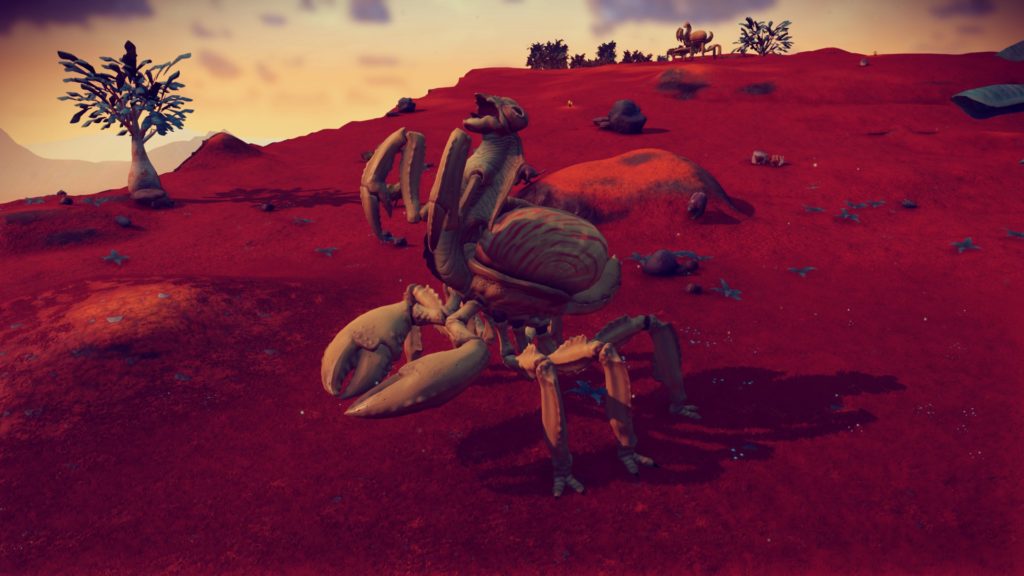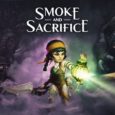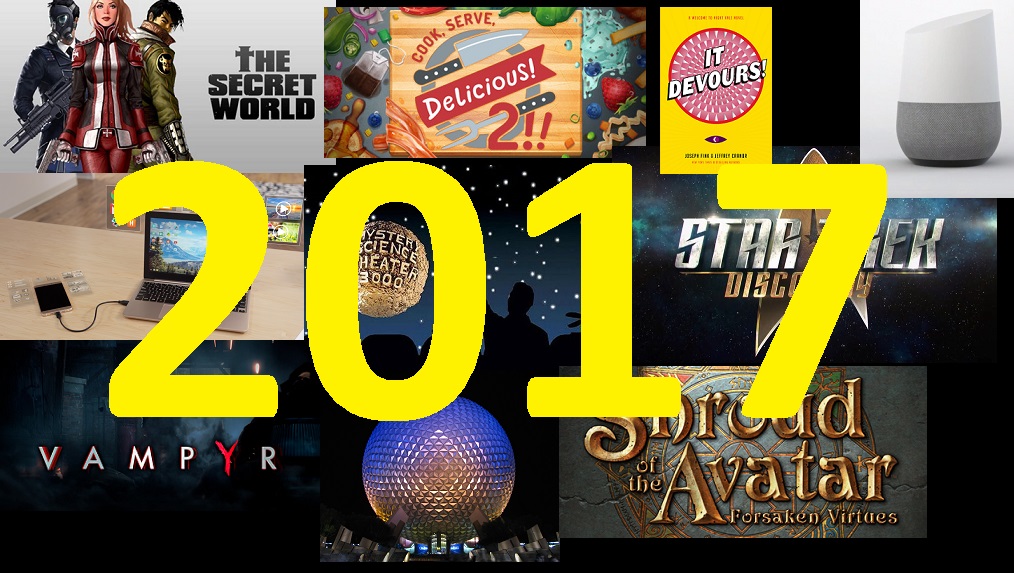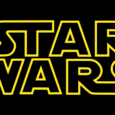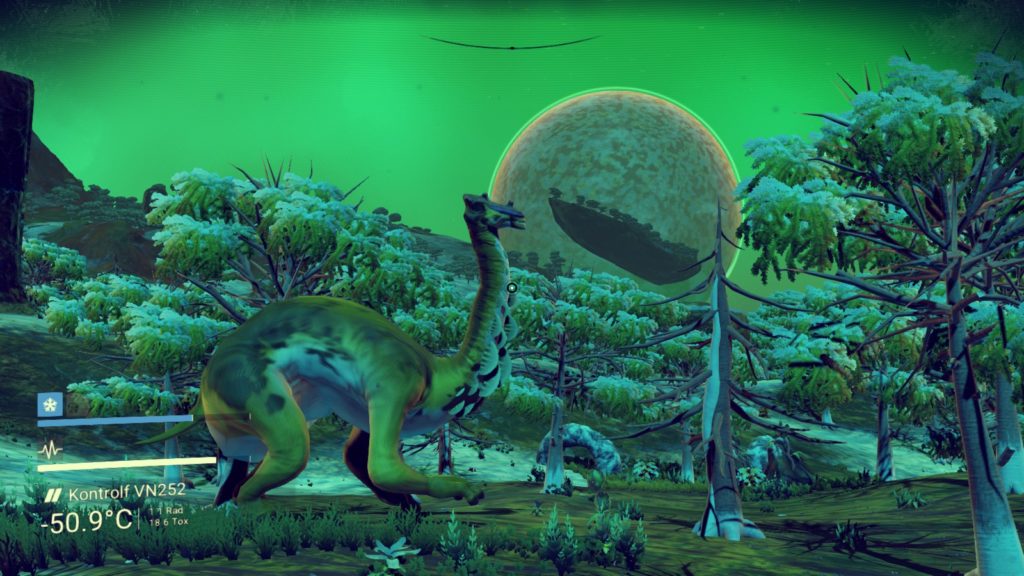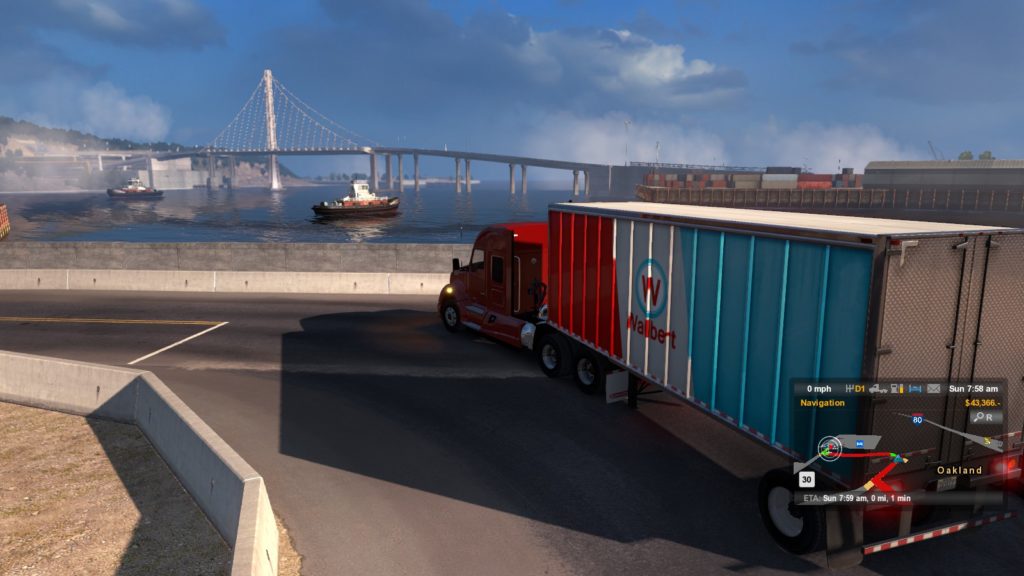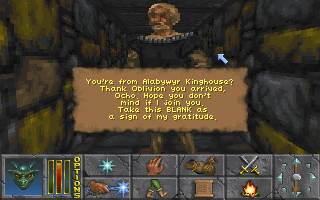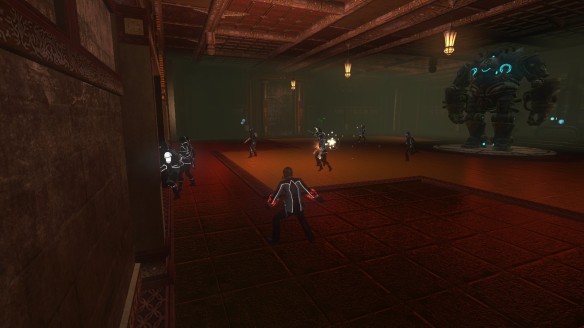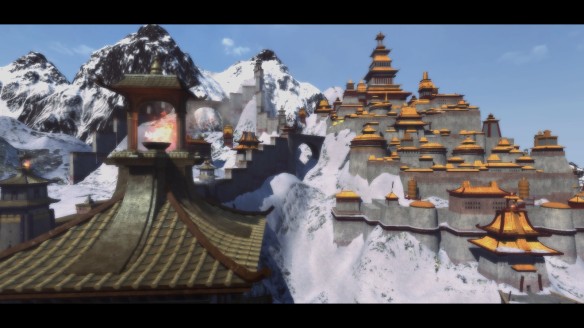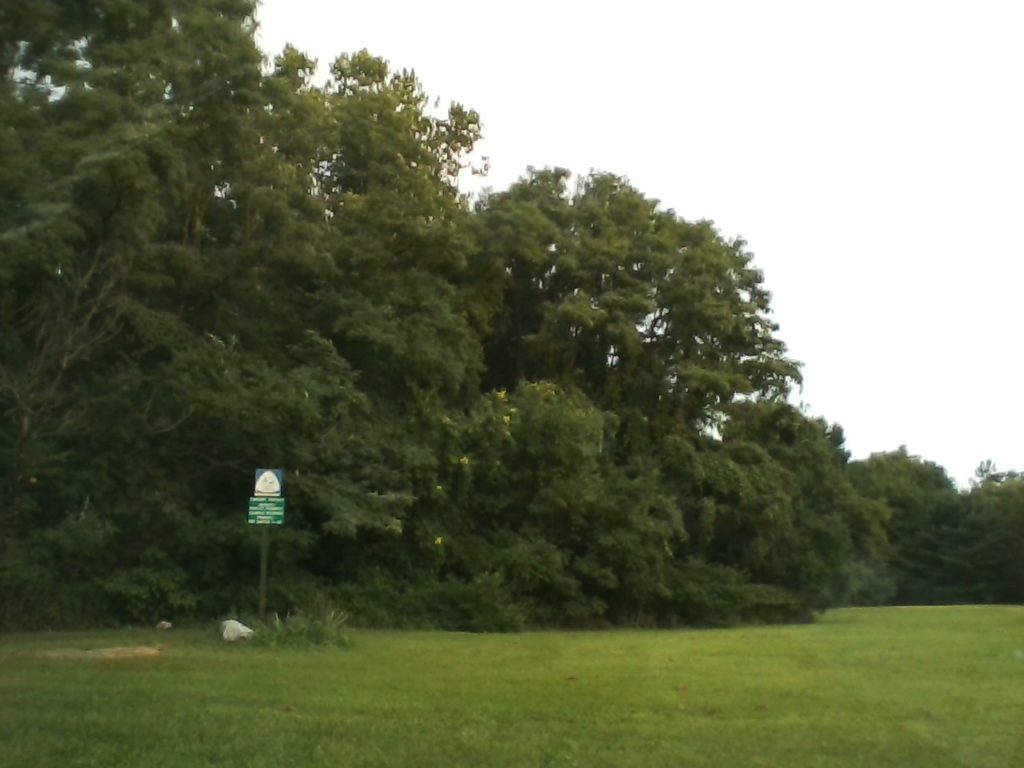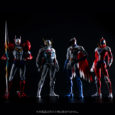It’s been a while since I’ve played No Man’s Sky and, to be fair, I thought I had completely written this game off entirely. When it first released in August of 2016, I fell deep into the hype trap, even shelling out the full $60 tag, something I am usually loath to do, and was subsequently burned. Once bitten, twice shy. After some more recent hype revolving around No Man’s Sky, though, this time with a $0 price tag since I’ve already bought into it, I decided to hop back in and check out what has really changed since launch. Find out what the ‘Next’ really means of the now titled ‘No Man’s Sky Next‘. Turns out, quite a bit has changed.
First of all, I find it weird that I’m using terminology and treating this game like it’s some sort of MMO, which now that there is some sort of real multiplayer going on I guess it is much closer to that. For all intents and purposes, though, No Man’s Sky Next still feels mostly single player. Which is fine by me. Usually, as a solo player, encountering other players in MMOs turns adversarial. We’re either fighting over the same drops, the same mobs, or fighting each other. That, as players, we’ve grown to consider this infighting ‘good, normal’ and ‘the way it should be’ is… odd. But I digress.
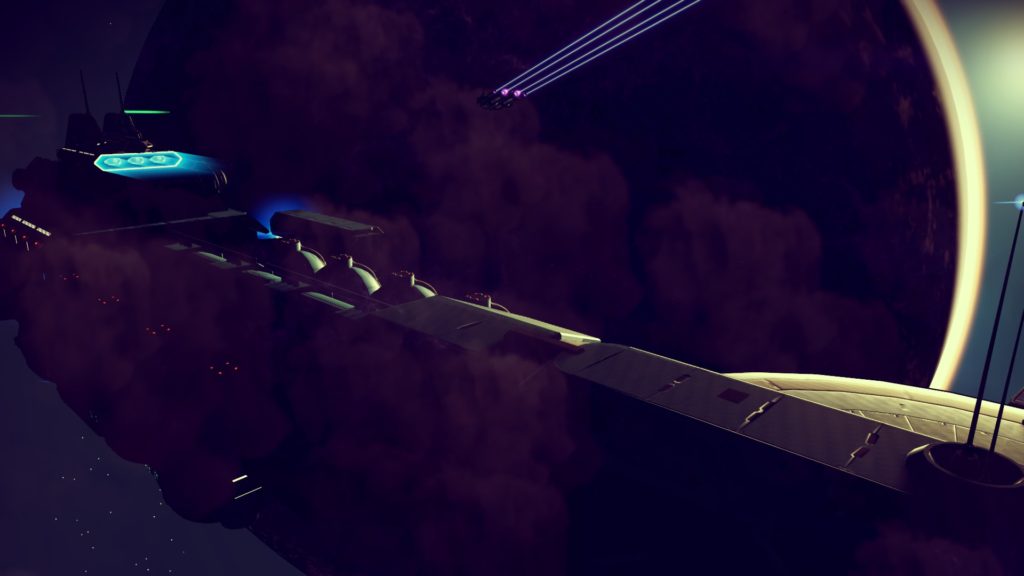
I delve back into No Man’s Sky Next after not touching it since release to see what has changed and if it’s worth playing again.
I remember when No Man’s Sky launched it felt like a wide ocean of content that was only a puddle deep. Everything was large and grand, but nothing felt important. There was no weight. Upgrades were acquired almost by accident and the primary focus was exploration… of similar, not-that-exciting locations. You could complete 99% of the game by just staying on the same planet you started on.
Now? Well, I’m not *entirely sold that No Man’s Sky Next is monumentally different, but it does feel a lot better. The focus has absolutely changed. Now, the focus is about building up your properties, your freighter fleet and your base, and completing the story missions. Your time spent on planets is transitory, hitting up only the points of interest you need to, and moving on. Which is good, because the less you see and pay attention to the procedural generation, the better. There was just not enough difference in the generation before. Now, it just feels… better. Planets feel more varied and look more populated. There’s more variety. I mean, there could always be even more variety in a game like this, but you don’t see the man-behind-the-curtain as much as you did two years ago.
Upgrades, too, seem to be made more from progress than from randomness, which is a much better feeling than just stumbling across the best weapon/ships in the game. That random big find is still included, too, though, but now instead of finding a big new ship, you now find a big *broken* ship that you need to spend a good chunk of time and resources fixing.
Again, it feels productive, not accidental. This is good.
Also, we need to talk about the screenshot capabilities. They are, hands down, the best screenshot options I have ever seen in any game. Period. And I consider myself a screenshot aficionado, so I don’t say this lightly.
At any time you can pause the game to take a screenshot. When you do, you can move the camera to any position around your character to take it, within a large distance. On top of that, if the lighting isn’t right, you can change the time of day and the position of the sun. You can add/remove clouds, change the depth of field, and even add an Instagram-like filter on top of all that. For real, all other games need to take a page from No Man’s Sky’s screenshot book. Screenshots are your players methods of advertising your game for you, and having a system like this only helps you.
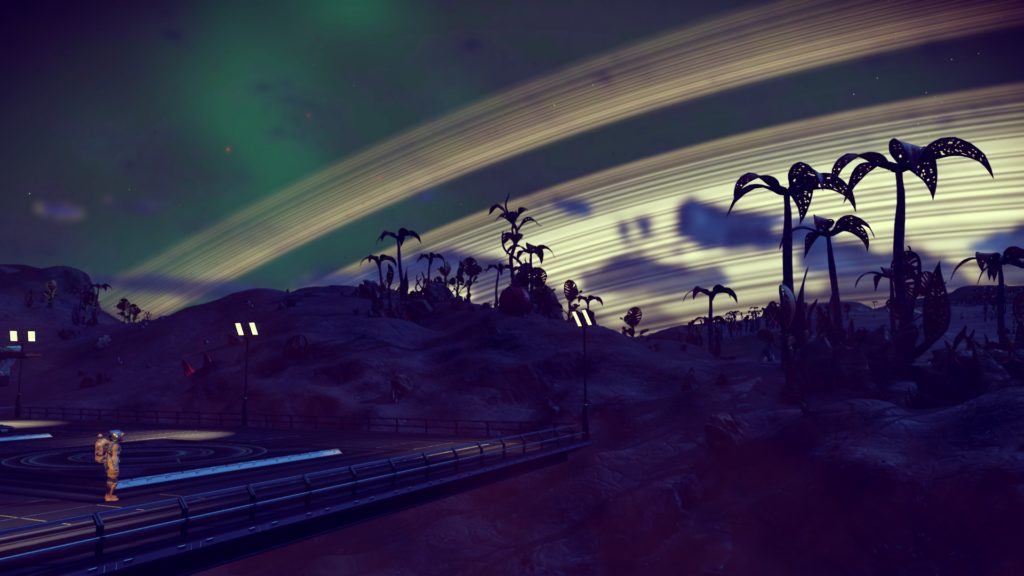
The Rings at Night! Glow Big and Bright! *clap clap clap clap* Deep In the Heart of… of… wherever this is.
So will I keep it up? No, of course not. I’m a rambling gamer and will pass quickly from game to game as my whim takes me. However, with No Man’s Sky Next focus having changed to one that feels purposeful instead of accidental, I’m a lot more apt to keep it going. Plus, the entire game fits into only a 10 GB footprint, which is efficient and impressive as anything.
It currently is still sitting at $60, though, which I wouldn’t say feels entirely worth it, but if it falls back down to $30, or even $40, I wouldn’t hesitate to suggest snapping it up. Have you hopped back into No Man’s Sky Next as well? Let us know on Twitter @SubCutured!
P.S. – If you’re looking for a good planet to settle down on, I highly suggest planet Ocho II in the Mucalls system. Red grass, bright sun, abundant resources, and a pleasant temperature all year long. Nice place to vacation. Just don’t murder me, okay?
With the head start of the relaunch of The Secret World into the new Free-to-Play Secret World Legends happening on Friday, June 23rd, and the official launch of Secret World Legends happening on the 26th, there isn’t much time left. Anticipation levels are running quite high as Funcom has been relatively tight lipped for the past couple months on complete details on the new game, including keeping beta testers under NDA up until launch and eschewing an open beta entirely. Still, in true Secret World fashion, a new ARG has come into play as a lead into Secret World Legends’ launch entitled “Kiss of the Revenant”.
If you’ve never played The Secret World then let me be the first to tell you about the game’s famed ‘investigation missions’. They are on a complete other level of devious. You think you’ve encountered tricky puzzles in other games, have you? Have those puzzles needed you to translate Morse Code from flashing headlights, research passages in the Vulgate Bible, or brush up on your Romanian? Didn’t think so. Solving these puzzles is a complete head rush, and the sense of accomplishment is like no other. Sure, you could just look up the answers, but you’d be shorting yourself of one of the best experiences in gaming today.
With that sort of history to live up to, this lead up has to be smart. To that effect, Funcom had the makers of one of the game’s previous tie-in ARGs, Alice & Smith of The Black Watchmen fame, set to work creating a new ARG to celebrate the release. According to a June 16th press release from Funcom, Kiss of the Revenant will have participants “Focusing on the solving of intricate puzzles and mysteries” where an “unsettling storyteller invites players to take a second look at a tragic love story on the Savage Coast”, the second zone of the game, which is also the location of The Secret World spin-off The Park. “Players will be challenged to decipher and perform a ritual that crafts an exclusive set of weapons for use in ‘Secret World Legends’.”
The ARG is currently up and running with participants helping to unlock milestones to release further content as the game progresses. It will run up to the launch of Secret World Legends on June 26th, 2017, and is free to participate. Just head to www.KissoftheRevenant.com to join. Also, be sure to check out the relaunch of Secret World Legends, starting Monday, June 26th, 2017. Details can be found at www.SecretWorldLegends.com. I know I’ll be checking it out and streaming it often as it has been hands-down my favorite MMO to date, and I can’t wait to see where the story will finally lead, to Tokyo and beyond.
Sidenote: Come check out the premier Secret World podcast Beyond the Veil’s live broadcast this Thursday, June 22nd, on Twitch. The show’s hosts, including myself, will be interviewing Andrea Doyon from Alice & Smith as well as Romain Amiel, Game Director of The Secret World and Secret World Legends.
Spring just arrived recently and winter has finally come to a close. So far in 2017 we’ve already seen quite a few great releases, the most recent being the Legend of Zelda machine, the Nintendo Switch, and the release of Mass Effect: Andromeda. As much as I’ve enjoyed Nintendo’s past offerings and felt the nostalgic pull of Zelda and since I’ve never actually played a Mass Effect game, they just weren’t on my list of upcoming things I’m looking forward to. However, on my list are other games, tech, events, and some are just random nerdiness.
In no real particular order, as they say, let’s get some 2017 HYPE!!
Sentio Superbook
I love me a good piece of tech. Who doesn’t really? In my tech arsenal, among other things, I have a smartphone, a tablet, a laptop, and a desktop PC. My smartphone I use all the time and my PC handles everything my smartphone can’t. The tablet and laptop though, I find gather quite a bit of dust. The tablet I only bring out when there’s an app that I would just like on a little bigger screen than my smartphone, and the laptop only when my main PC is down and I still need to perform desktop-like tasks. Those times are far and few between and every time I turn them on they have hundreds of updates waiting.
This is where the Sentio Superbook comes in. Using an Android app that turns the Android OS more desktop-friendly, the Superbook is essentially a laptop shell that uses your smartphone for the processing power. According to the Kickstarter, the Superbook “provides a large screen, keyboard and multi-touch trackpad, 8+ hours of battery, and phone charging capabilities”. Always up to date, and never falls behind your Android’s tech. This I can see completely replacing my tablet, fitting usefully between my phone and desktop.
Release: Pushed back from February until June for initial Kickstarter orders.
Return of Mystery Science Theatre 3000
Fun fact: I’m an original card-carrying member of the MST3K fan club. I remember having Thanksgiving at my grandmother’s house, eating myself silly, and then relaxing watching the Turkey Day marathon. I didn’t have cable growing up, which is how I’m easily able to live without cable today, but MST3K was a treat. When they announced they were Kickstarting a new season, I legit threw money at my screen. Got myself the t-shirt to match my older MST3K t-shirt, a couple nice prints, a keychain (I think… don’t tell me I’ve already lost it…), and the satisfaction that I’ll be able to watch brand new episodes. To answer your burning question, I think Joel was better than Mike. Fight me.
Release: April 14th, 2017! So close I can taste the movie sign.
Cook, Serve, Delicious 2
I’d like to think that when I game on PC, the games I play are complex and deep. However, I’ve never wanted that complexity on my phone. For mobile gaming I like keeping it light and in small increments, hence why the Switch was never a draw. Cook, Serve, Delicious is quite possibly one of the best mobile games I have ever played. It’s light, tricky, takes a bit of skill, never felt like the phone hardware ever got in the way, and had entertaining graphics to match. You don’t have to play it on mobile, you can play it on other systems, but it shines on mobile. So when they announced CSD 2 at the end of 2016, I was giddy. Giddy.
Release: “Available on Steam and PS4 in 2017“. Not specific, and no mention of mobile, but their alpha trailer was released in Dec 2016, so hopefully soon.
Star Trek: Discovery
CBS announced in November 2015 that following the 50th anniversary of the original series of Star Trek, and 12 years after the last official Star Trek: Enterprise episode aired, they would be opening a new chapter in the Star Trek Prime universe. Yes, the Kelvin timeline exists, and while I personally really enjoyed Beyond and what the reboot has brought to the series, it’s no Prime Universe goodness.
Set 10 years before Captain Kirk started his famous 5 year mission, they’ve announced the main protagonist will be Lieutenant Commander Rainsford, played by Sonequa Martin-Green, and referenced in the show as “Number One”. Star Trek: Discovery will revolve around the USS Discovery, although they’ve announced casting decisions for a second ship, the Shenzhou, and a number of Klingons. This, and other rumors, hints that the plot may revolve around the Klingon-Federation scrap-up at Donatu V, mentioned in the episode The Trouble with Tribbles which led to a Cold War between the two factions.
The show will initially air in the US on CBS, after with episodes airing on CBS All-Access shortly after. Outside of the US, episodes will air on Netflix. I personally don’t care how they air it, I’m just psyched for new Star Trek!
Release: As of this writing, it appears to have been pushed back until late summer/early fall, with possibilities of being pushed back further. Blech.
Vampyr
If you haven’t yet played Life Is Strange by DontNod Entertainment, by god what are you waiting for?! Go play one of the most fresh and stunning games you’ve ever played! If you have played it, then you probably understand why Vampyr, another game in production by DontNod Entertainment, has me so excited. Action-oriented with a sort of Assassin’s Creed meets the episodic genre vibe, set in 1918 London? Sign me up. I don’t play brand new games often, but with this setting and story potential, I’ll play.
Release: This site is suggesting Q4 2017, maybe just in time for Halloween?
Disney World’s EPCOT Big Changes Announcement
I’m a Disney World nerd. What can I say, I’ve visited the parks quite a few times and each time have had some amazing experiences. Nothing beats having fun all day with family and friends, seeing all the sights, riding the rides, and sitting down for one of the best meals you’ve ever had in your life. Cap it all off with a phenomenal show and fireworks every night you’re there! I wasn’t so much a fan before I met my wife, but now that she has shown me what I was missing, I’m a big fan.
So when Disney makes changes to their parks, which happens all the time, it just makes me excited for the next time that we’ll visit. At this point, it may be a few years before the next trip, but by then hopefully the big EPCOT changes announced at the D23 Expo last November will have come to fruition. When the Chairman, Bob Chapek, tells the Imagineers to “dream big” and to expect a “major transformation,” I’ll lap up any news like I’m dying of thirst. I mean, shoot, they’re adding hanging gondolas to their transportation roster. Gondolas! How cool is that?!
Release: Changes won’t happen for a few years, but hopefully we’ll hear what they will be at the next D23 Expo July 14th-16th 2017.
Shroud of the Avatar Launch
All the way back in May of 2013, one of computer gaming’s legends, Richard Garriott, started a Kickstarter campaign with his company Portalarium to bring back a “spiritual successor” to one of the most influential game series of all time, Ultima, called Shroud of the Avatar. Since I’m a huge fan of the Ultima games to this day, I backed it to a non-ridiculous degree. To say that it’s been a long journey since the Kickstarter launch is quite an understatement. Like most Kickstarted projects, the feature creep has been quite extreme, to the point that the game still hasn’t been completed yet in full. Posing primarily as an MMO, the features they want to add are story mode with content delivered in episodes, written by Garriott and Tracy Hickman, a single player offline mode, different multiplayer modes, a vast classless character system, PvP, player housing, a crafting-based economy, full guild systems, player owned towns, and all the other accoutrements one would expect with MMOs these days.
As of right now, Shroud of the Avatar is still in a beta state and they stopped issuing character wipes in July of 2016, but still has not officially “launched.” I’m not one to play incomplete games though, so if they don’t consider the first big chapter complete yet, I have no issues waiting. I’ll finally jump in once they start officially calling it “launched.”
Release: 2017, or so the FAQ says.
More Google Home Updates
Near the end of last year, I took the plunge into home automation and bought a Google Home while it was on sale. To say the least, my wife and I have been enjoying it quite thoroughly. I quickly discovered that home automation is a deep rabbit hole, with Google Home itself being the gateway drug. It started with one Google Home, then a second, and then a Chromecast Audio to sync all of the speakers together to form a whole-house audio system. A Philips Hue starter kit later and we had voice-controllable lights. Ten more bulbs later and we rarely touch our lightswitches anymore.
We bought it early on in its development because we expected more functionality to come, and so far they haven’t disappointed. More, though… we want more.
Release: Ongoing, since Google Home has already been released in 2016.
Welcome to Night Vale‘s 2nd Novel: It Devours!
If you’ve never heard of the quirky podcast Welcome to Night Vale, you are sorely missing out. Based around the community radio station of a fictional, and quite strange, desert town located somewhere in the southwestern US, Welcome to Night Vale has been chronicling the town’s oft-bizarre happenings since June of 2012.
In 2015, WTNV’s creators Joseph Fink and Jeffrey Cranor released their first novel, Welcome to Night Vale, based on the town. More heartfelt and personal than I was expecting, I enjoyed it, so I was excited when during the episode “After 3327,” they announced a second novel! Finally, around mid-March they announced the title and a release date of October 17th, 2017.
Release: According to Joseph Fink, they handed in the final manuscript on January 17th and in Mid-March they announced a release date of October 17th, 2017.
The MMO The Secret World‘s Relaunch
Finally, the last thing I’m excited about for 2017 is the “relaunch” of the MMO The Secret World, a personal favorite game of mine. The news of Funcom’s plans to relaunch it’s 5-year-old title came as a bit of a surprise, having been “announced” on Funcom’s 4th Quarter 2016 financial reports. Boasting changes from a redesigned new player experience, a “major improvement” to gameplay and combat, new player retention systems, and changes to the game’s business model, a lot of players are simultaneously nervous and excited for the upcoming changes. Funcom’s community team has been silent on the subject, focusing first on PAX East and Conan Exiles before making any big announcements about The Secret World.
Release: We’ll most likely hear more about the relaunch by the end of March, and see some changes before the end of June.
Having had technology and the acquisition of technology be one of my foremost hobbies over the past decade or so, I’ve come to a very distinct realization: Technology, at its core, is just a tool. Seems simple, right? A tool is just an implement used to carry out a particular function. Like a hammer is just a tool. In game development, designers use multiple tools in their creative works, one popular tool of late is Procedural Generation.
Procedural Generation, at its heart, is the process of programming an application to design the content of a game using and working within a specified set of parameters. The use of procedural generation in video games goes hand-in-hand with the genre itself. Games like Rogue (1980), of which the term Roguelike is derived, was nothing but procedurally generated dungeons, one after another, that the player was meant to explore. This gave the game a never-ending appeal, where a little bit of code gave you a game that was always different than the last. Procedural generation has been used to do everything in gaming from creating environments, to dungeons, to loot lists, to sprawling towns and populations. In the end, though, it’s just a tool.
Everybody’s Sky
Kyle, one of the writers here at Sub-Cultured, has been enamored with No Man’s Sky. For good reason, too. No Man’s Sky, first off, is gorgeous. The art styles, the visuals, and the chance of seeing things nobody else is seeing are some of the game’s big positives. I also picked up the game within its first week of release and had some fun exploring the few worlds that I found, but in the end I found myself quickly losing interest. Yes, the worlds themselves could, at times, be very pretty, but I had a hard time feeling that anything I was accomplishing was meaningful or significant.
I was exploring all of these places that had already been explored before, I was re-naming animals and plants that were located around small settlements and surrounded by floating machines, constantly scanning them, and I was learning languages that, even after learning a metric ton of words, I still couldn’t understand what anyone was saying. Nothing I was doing felt like it had any impact on anything, or at worst felt like I was just already going where everyone had already gone before.
Overall, I blame the procedural generation and how heavily they used it. It is the hallmark of the game, how what you were seeing was never seen by any other player and it was special to you. Except that it had been seen before. When I came across my 50th giant tooth shaped plant (and was naming it ‘Yet Another Giant Tooth’), or my 30th wolf-looking creature with fungal spores all over it (‘Yet Another Diseased Wolf’), I had reached my limit.
No Man’s Sky‘s use of procedural generation, their hammer, felt like the only tool they were really using seriously, and when it duplicated assets, it was glaring. Any “story” was coming at what felt like a snail’s pace, and progression was also a slow process. This means that the way the developers wanted you to play involved just hitting one procedurally generated planet after another. Which means also seeing the same formations over and over in maybe varying colors or sizes. I’m not sure which writing outlet first used the phrase “18 Quintillion Bowls of Oatmeal“, but it certainly feels apt.
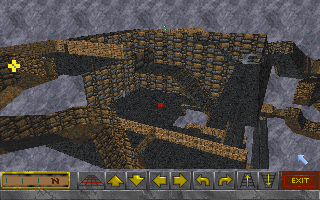
Daggerfall, one of the first 3D attempts at mapping seen in a video game. Not a great attempt, though.
ProGen Behaving Badly
Let’s be real, though, No Man’s Sky isn’t the first to overuse procedural generation. One of the biggest games of all time, literally, is one that used procedural generation to launch a franchise: The Elder Scrolls: Daggerfall. Coming off of the successful Arena, Bethesda wanted to make a game that truly felt like a world. Some sites posit that the full landmass of Daggerfall reaches a staggering 62,394 square miles! I started playing it not long ago and it isn’t kidding around. If you were to walk from one town to another, even if those towns were right next to each other, it would take you HOURS to do so. With 15,000 towns, cities, and villages to explore, the game wasn’t messing around. The first thing you bought was a horse and a wagon, because without them you were hosed.
The landmass of Daggerfall wasn’t even the worst of the procedural generation, though, it was the dungeons. Daggerfall‘s dungeons took multiple dungeon “sets” and patterns and hooked them together to form an overall dungeon. Combined with an uber-confusing three dimensional mapping system, Daggerfall would turn a simple low-level dungeon into an hours long slog through random-mob infested hallways, where sometimes monsters well above your level would lie in wait to wreck you. To put it lightly, Daggerfall‘s use of procedural generation was simultaneously complete overkill, frustrating, and completely unforgiving.
Randomness Isn’t Really Exploring
One of my favorite things to do in games, though, is exploration. I will look behind every nook and cranny, every little path, every little tiny area, and in most games that exploration is nicely rewarded with either a nice sight, some extra loot, or some easter egg. They are specifically placed on the game map by the developers, though. When you start making everything through procedural generation, you lose those little rewards. Everything you could possibly encounter by checking every nook and cranny is just as available as any other point. The entire gaming world gains a homogeneity that stops rewarding exploration simply by its very nature.
There was a poll given by the developers of Star Trek Online on their forums once that once asked the players “What do you really want to see in Star Trek Online?” The biggest response back was simply “Exploration”. Since the tagline of Star Trek is “To boldly go where no one has gone before”, though, this shouldn’t come as a surprise. The problem was that the game already had an “exploration” system. They combined random scenarios, randomized enemies, randomized aliens, and placed them on some randomized maps. To the majority of players, although what you were seeing was fresh, it didn’t “feel” like exploring.
I don’t blame the players, though, it truly *didn’t* feel like exploration. To hit this home, the game that I play that hits that exploration button the best is American Truck Simulator. Sure, ATS uses some procedural generation to save time on creating the environments, but it’s seeing all the specific locations and special places that makes the exploration worthwhile. It isn’t what is random that taps that exploration feeling, it’s what is purposefully placed that you’re seeing for the first time.
ProGen Is A Good Tool, But Shouldn’t Be The Only Tool
If you take a look at some of the best games of our day, though, like Diablo, you’ll see that they all use procedural generation. However, their use becomes reserved to creating large, similar themed environments without sacrificing development resources and isn’t a crutch. Procedural Generation isn’t going to go away anytime soon, and it really shouldn’t because it’s such a useful tool.
What makes a great game, though, is using many different tools in its construction. Use some ProGen, some story, some good mechanics, decent audio, music, setting, etc. and put all together you have a great game. Relying on any one tool will make that tool stand out and show its flaws.
No Man’s Sky I feel was relying just too heavy on the procedural generation, and it was their downfall. Even compared to a game like Elite: Dangerous that also relies on space exploration and a ginormous universe, Elite feels more fleshed out and your actions feel like they have more weight.
I hope that we haven’t heard the end of No Man’s Sky, though. It has so much potential and can be so much more than it is. It’s at a good starting point and can only go up, but it will definitely need something more than just procedural generation to get players back.
Do we really *want* the items that are proferred to us in MMO events? Or just the ability to pursue them?
The thought struck me as I finished up yet another losing El Dorado PvP match in The Secret World. It’s a faction based, collect and hold items sort of PvP match. In all the matches I’ve played so far, the Illuminati haven’t won a single one, it’s always been dominated by those dang Templars or Dragon. At least I was able to check off another daily challenge and that’s all that matters in the special item-of-the-month chase this time around.
The item up for winning is the Doomboard, a Hell-themed hoverboard mount. Do I want it because my character really “Hell” themed? No, not really. I style him more as your average joe-next-door. I don’t even think it looks that great, but… it’s an item to chase, and I do love The Secret World. So why not chase it? The chance to chase limited-time items isn’t one that comes around often in TSW, and any reason to play TSW is a good reason.
The worst part is, though, I don’t even *like* PvP. I’m not a competitive person and beating my fellow players isn’t something I would actively seek out. Then again, grouping up with them isn’t something I’ve necessarily enjoyed, either. I’ll do it periodically, just to check out some content I’ve never seen, but grouping for dungeons in MMOs I’ve found is just as competitive as PvP, if not more so. Sure, you’re all after the same target and same goal, but gear discrepancies, different builds, or experience will still separate you into the gaming haves and have-nots. And some players will go out of their way to tell you how much they think you’re a “have-not”. Social PvP, if you will.
To get the Doomboard, though, PvP and Dungeon running are a must, so I’m heading outside my comfort zone and trying new modes of play, just as the developers intended. I’m all up for trying new things, and now I have some nice self-made-builds for when I head down into PvP or dungeons, so there is that. Plus, I’m getting nice chunks of reward to keep making gear progress, too.
The next-to-worst part, though, is that I may not even get it! Due to my reluctance and inexperience in the highest levels of running dungeons and content, I can still only complete just a few challenges a day, which puts me at an uncomfortable amount of playtime to get the remaining challenges completed. Dang it if I still won’t try, though, comfort zones be damned. If we all stayed inside our comfort zones, how would we ever grow?
In the end, if we didn’t enjoy the game itself, we wouldn’t care at all about the digital tchotchkes on offer. Sometimes, even the smallest of carrots is all it takes to get us interested again. Be it a starship that has never been flown, a special hat, a mount that will never be ridden, or a Hell-themed hoverboard. What matters is there’s a goal on offer, and if that goal is within reach in the slightest and we enjoy what it takes to get there, then why not chase after it.
I was at home scrolling through my Facebook feed on my phone, watching some small video that a friend reposted, when my 10 month old LG G4 rebooted itself.
In the world of small consumer electronics, that event is usually nothing special. It doesn’t happen all the time, but having a device say “You know what, I just need to reboot” does happen. We shrug, wait the few minutes for the device to restart, and go right back to where we were. My LG G4, though, got stuck in a booting loop and wouldn’t return to a home screen.
Unbeknownst to me at the time, my LG G4 had a hardware issue that was just counting down to when the phone would die (no recall notice, LG?). According to LG’s January 2016 statement to Android Authority, “LG Electronics has been made aware of a booting issue with the LG G4 smartphone that has now been identified as resulting from a loose contact between components.” Once that contact comes loose the phone bricks and becomes unusable. For some users that time is sooner, for some later. If you have an LG G4: Be prepared.
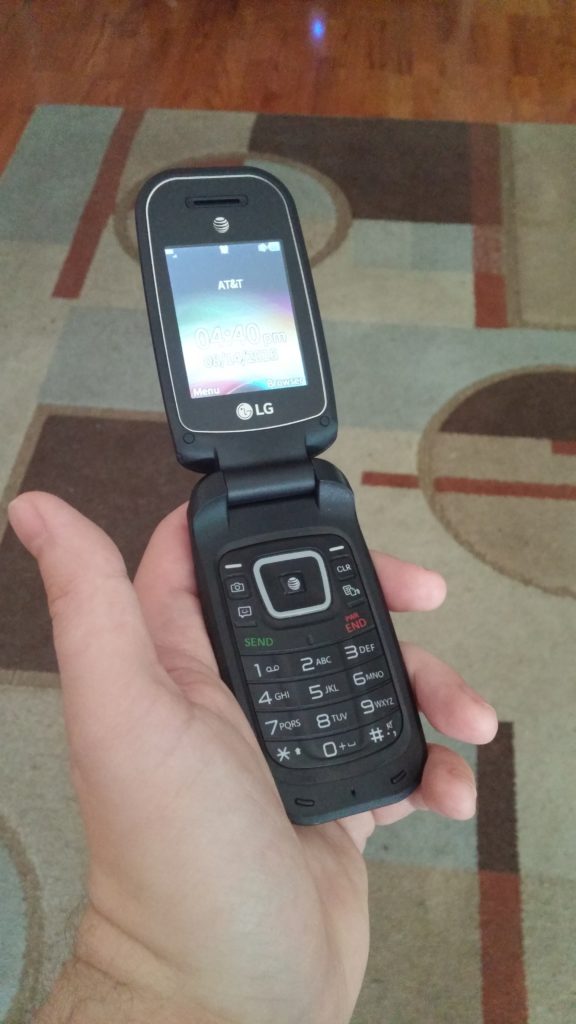
A *NEW* LG B470
To the Strip Mall!
The good folks at our local AT&T store, whom we have always been treated with respect by, seemed to have their hands bound. I didn’t buy the insurance, but I was still within the warranty. The associate said they would have a replacement LG G4 shipped out to me, but it would take about a week to do so.
A week. A decade ago, we didn’t have smartphones, but their invention and proliferation has changed society as we know it. My wife and I don’t have a landline in our condo, specifically because we both have cell phones. An extra line would just be redundant, and I’m not about to give Comcast any more money than I absolutely have to. A week with no phone calls or texts can be done, but in this age of information, it’d be like willfully going deaf. Others would try to communicate, but I wouldn’t be able to hear them or even know they tried. Like it or not, cell phones have become a necessity of daily life.
My options were few. I couldn’t trade my phone in early for a new model, because it technically was broken. AT&T also doesn’t have a “loaner” program (seems like an oversight, this would inspire customer confidence). I also couldn’t pick up a phone and return it a week later, as this would incur a hefty “restocking” fee. So I did what I had to do, I bought their cheapest phone available on the spot, an LG B470 flip phone.
Living in the Aughts
I bought my first cell phone in 2001 at the same time as my then-girlfriend. Terrible decision. Don’t join in any contract with someone unless you’re committed to them. Life lesson. From there, it was flip phone to flip phone until 2010.
When my wife and I got married in the summer of 2010, the flip phone that I was rocking was destroyed on our honeymoon by a freak thunderstorm. Seeing as we were newlyweds and about to board a cruise out of country, my phone was the last thing on my mind. When we returned we bought a pair of our first smartphones, the Galaxy S.
This was only 6 years ago. Such a small time in the grand scheme of things, but such a large change in daily life.
Reaching for No Reason: The first thing I became acutely aware of with a flip phone in 2016 was exactly how often I would reach for my phone. Multiple times throughout the day I check my smartphone for new email, new social media comments, or other app fluff. With a phone that really only receives calls or texts, I keep flipping the phone open but then quickly realize it’s futile. It doesn’t have those frills, and if I get a call or text, the phone will let me know.
No GPS or Weather: Without Google Maps or weather widgets, I’ve felt a little lost (pardon the bad pun). Yes, I know, we use to get by without GPS maps and up-to-the-minute weather just fine. But with Google Maps and GPS devices, I’ve long rid my car of local maps. Also, storms just passed through this morning, and I had no idea they were coming. I could’ve used my home PC or work PC to check, but these are both things I have mentally relegated to my smartphone.
No Curated News: I also have felt much less informed overall. Lack of a smartphone means a lack of those in-between moments to check current events. I use social media, but I primarily use it to get my daily news. Groups that I’ve joined are both social interactions and a curated news delivery system. Yes, tell me all the news about Ultima, Star Trek, and Disc Golf! I’m all for them.
No Podcasts: All the podcasts that I keep up with will just have to be skipped this week, too. I won’t clean my house any less, but where I was listening to podcasts during my commute or while cleaning now will be silence or background music.
Tiny Pictures: And pictures on this little flip phone are laughable. Sure, I could take some, I guess, but without the ability to share them, what’s the point? We passed a business yesterday that it advertising itself as a “Cat Lounge”, and I didn’t even bother taking a picture to ask everyone what they thought that meant. I have no idea. A salon? A bar? Are cats welcome? What *is* that?! I couldn’t post the picture even if I did take it.
It’s not like these are monumental changes by any stretch, and are small annoyances at best. They highlight, though, just how integral these little devices have become in our daily rituals. It’s not in the large interactions that they found their use, but in the small periods of time between interactions. That podcast on the drive home, that quick check of social media in the bathroom, that look at the forecast in the morning.
The Reports of the Death of Social Interaction Have Been Greatly Exaggerated
People complain about how things were better before smartphones, though, how we talked to each other more and didn’t have our faces glued to screens. This is hyperbole, of course, but if anything my technological regression is making it clear how it’s *not* the devices that are to blame. People are.
If someone feels compelled to stick their face in a screen over having worthwhile human interaction, that’s the person doing that, not the device. That person who rudely talks on their phone while ordering coffee? That’s a rude person, not a rude phone. It’s essentially the “guns don’t kill people, people kill people” argument, but applied to cell phones. Which is totally true. It’s the act that matters, not the device (cell phones aren’t designed solely for the purpose of death, though, which is the true basis of the guns argument).
So if you’re blaming your bad habits on your phone, nope, you’re in the wrong on this one. The phone is just an outlet to flex those bad habits, but you’re still the one doing them. Same goes, though, for blaming the downfall of society on devices or games. If all it took was a cell phone to trigger the downfall of society, then it wasn’t being held up by much in the first place. Stop blaming Pokemon Go on people’s lack of awareness, blame the unaware people.
A Return to Normalcy
Can’t wait to get my replaced G4 back, though. The feeling of connection, of direction, of making those in-between moments useful again. This has been a fun experiment, and it’s been interesting to note the minute changes in daily life that have snuck up over the years. Every once in a while it’s good to remove yourself from your comfort zone, if only to measure how much you have changed. But, seriously, AT&T, where’s your recall or loaner phone program?


